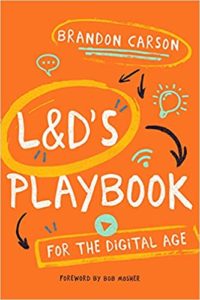
Here are reviews of six newish Learning and Development books of interest that I came across this year. They coveri a range of topics within and outside of the field. Included in this article are books by Guy Wallace, Myra Roldan, Brandon Carson, Mark Britz, Luke Hobson and Patti Shank. I hope you find one here that expands your world. The reviews are alphabetical by title.
Conducting performance-based Instructional Analysis: In Every Phase of an Instructional Development Effort by Guy Wallace
In this comprehensive book, Guy Wallace presents his Modular Curriculum Development (MCD) methodology and demonstrates how to conduct an analysis in every phase. The MCD framework is a full performance-based instructional design model. It is particularly valuable for instruction that involves complex and high-stakes performance.
Many readers will benefit from the thorough front-end analysis process that Wallace presents. But there is so much more here. As many have been preaching for years, the focus of instructional design should be on tasks and outputs that improve performance rather than solely on content. Read this book to find out how it’s done.
Design a Voice User Interface: Workbook by Myra Roldan
You probably use voice-assisted technology to help with simple tasks. As this technology becomes more sophisticated, it will undoubtedly become integrated into learning experiences. That means you’ll want to know how to design for the voice user interface (VOI). Like any aspect of design, there are new principles and best practices to master.
Author, Myra Roldan, offers a self-paced workbook to help you design your first VUI. This is the same workbook that she uses in her Voice User Interface Workshops. The workbook guides you through the steps for getting started, designing and implementing an effective conversational design.
Following along in the workbook, you’ll learn how to design a simple program for a fictitious course on Adulting 101. The exercise is fun and practical. And when you’re finished, you’ll have a foundation for exploring the possibilities of voice user interface design.
L&D’s Playbook for the Digital Age by Brandon Carson
In this book, Brandon Carson pulls off an admirable feat—detailing the strategies organizations will need to excel in the digital age. The book begins with the dramatic disruption of business and work due to three factors: migration and globalization, technology (AI, the cloud, and data) and the rapid transformation of work.
How this affects Learning and Development is key. Carson writes that organizations will depend on L&D more than ever before. Leaders must ensure they have a capable and prepared workforce to handle the changes ahead. L&D leaders will need new methods and strategies to survive and thrive while creating a human-first environment.
The book demonstrates how every learning leader must plan and execute a meaningful playbook for their organization. Anyone with a leadership role and those who want a big picture view will benefit from reading this book. It’s impressive.
Social by Design: How to create and scale a collaborative company by Mark Britz and James Tyer
Social By Design helps readers understand the snowball effect that social interactions have on the workplace. Authors Mark Britz and James Tyer present a compelling argument for why a social design should be at the core of an organization’s DNA.
The thesis goes like this. When an organization is social by design, people build trusting relationships that foster connection, conversation, collaboration and sharing. It creates an environment that is ripe for creativity and innovation and one where people can find growth and meaning.
The three core chapters of the book are wrapped around one of three principles that leaders can adopt to begin the transformation into a social organization: 1) social is uncontrollable; 2) conversation creates movement; and 3) people over technology. In each chapter, the authors guide the reader through a thoughtful implementation of each principle. Blending philosophy, research, case studies and practical know-how, I think this book is a must-read.
What I Wish I Knew Before Becoming an Instructional Designer by Luke Hobson, PhD
Maybe it’s going too far to say that Instructional Design is trendy. But an increasing number of people are seeking a way to enter the field and they need guides to help them down the convoluted path. Luke Hobson has written a guidebook that shines a light on how to start a career in instructional design.
In a breezy and informal style, Hobson answers many of the most common questions a curious seeker will have. The book covers topics for those who are early in the process, such as what instructional designers do, the different sectors where one can work, planning for the future, upskilling, building a portfolio, making connections and whether to get a degree. Hobson also walks through what you may need to know when working as a new instructional designer.
This book is bound to help many people get clear on what they need to do to prepare for their next career step.
Write Better Multiple-Choice Questions to Assess Learning: Measure What Matters— Evidence-Informed Tactics for Multiple-Choice Questions by Patti Shank, PhD
As a Patti Shank fan, I knew this book would be worthwhile reading before I even opened it. Writing reliable and valid assessment items is one of the most difficult tasks of the instructional designer and educator.
In this well-researched book, Shank provides an excellent resource about this complex subject. Here you’ll find the importance of writing accurate learning objectives, how to write assessment items correctly and guidance on writing higher-level questions. She also covers other question formats, providing feedback and scoring issues. In addition, the book is sprinkled with practice exercises and answers, chapter insights, and lots of references. I nominate this as required reading for all learning professionals. Listen to my interview with Patti about Practice and Feedback.








Leave a Reply